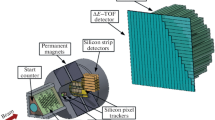Abstract
This paper describes events of anomalously high energy transfer to a micro-object by fragments of nuclei generated in nuclear interactions in the environment on board a spacecraft in flight in low-Earth orbit. An algorithm has been developed that allows for the calculation of the absorbed energy from one or more fragments - products of nuclear interaction. With this algorithm the energy distributions for a spherical micro-volume in an aqueous medium were calculated. And the resulting absorbed energy spectra from nuclear fragments and from primary cosmic rays were compared. The role of nuclear interactions in events of large energy transfers in micro-objects in the field of primary cosmic radiation has been evaluated. The calculations performed in this study showed that the energy in a micro-volume from nuclear events can be several times higher compared to the energy imparted by primary space radiation.





Similar content being viewed by others
Data availability
No datasets were generated or analysed during the current study.
References
Ambrožová I, Davídková M, Pachnerová Brabcová K, Tolochek RV, Shurshakov V. A (2018) Contribution of different particles onboard ISS measured with track etched detectors. Radiat Prot Dosimetry 180(1–4):138–141
Badhwar G, Golightly D, Konradi MJ, Atwell A, Kern W, Cash JW, Benton B, Frank EV, Sanner AL, Keegan D, Frigo RP, Petrov LA, Tchernykh VM, Akatov IV, Shurshakov YA, Arkhangelsky VA, Kushin VV, Klyachin VV, Vana NA, Schoner N, W (1996) In-flight radiation measurements on STS-60. Radiat Meas 26(1):17–34
Badhwar GD, Atwell W, Cash B, Weyland M, Petrov VM, Tchernykh I, Akatov V, Shurshakov YA, Arkhangelsky VA, Kushin VV, Klyachin VV, Benton NA, Frank EV, Benton AL, Frigo ER, Dudkin LA, Potapov VE, Vana YV, Schoner N, Fugger W, M (1997) Intercomparison of radiation measurements on STS-63, Radiat. Meas 26(6):901–916
Badhwar GD, Kushin VV, Akatov YA, Myltseva VA (1999) Effect of trapped proton flux anisotropy on dose rates in low Earth orbit. Radiat Meas 30:415–426. https://doi.org/10.1016/S1350-4487(99)00068-2
Beaujean R, Kopp J, Burmeister S, Petersen F, Reitz G (2002) Dosimetry inside MIR station using a silicon detector telescope (DOSTEL). Radiat Meas 35:433–438
Benton ER, Benton EV (2001) Space radiation in low-earth orbit and beyond. Nuc Inst Meth B184:255–294
Caffrey GA, Hamby DM (2011) A review of instruments and methods for dosimetry in space. Adv Space Res 47(4):563–574
Caffrey GA, Hamby DM (2013) Space radiation dosimetry: overview and recent developments. Recent Pat Space Technol 3:3–12
Deng L, Li G, Zhang BY, Li R, Zhang LY, Wang X, Fu YG, Shi DF, Liu P, Ma Y, Shangguan DH, Hu ZH, Zhou SC, Shen LW (2022) A high fidelity general purpose 3-D Monte Carlo particle transport program JMCT3.0. Nucl Sci Tech 33:108
Durante M, Cucinotta FA (2011) Physical basis of radiation protection in space travel. Rev Mod Phys 83(4):1245–1281
Fedotov SN, Kushin VV (2021) Methods for obtaining linear energy distribution in a small volume from nuclear fragmentation events caused by space radiation. Nuclear Inst Methods Phys Res A 995:165114. https://doi.org/10.1016/j.nima.2021.165114
Fedotov SN, Kushin VV (2022) Description of nuclear fragmentation events induced by space radiation: analytical approach. Nuclear Inst Methods Phys Res A 1034:166821
Fedotov SN, Kushin VV (2023) Distributions of energy imparted to a micro volume by secondary charged fragments of nuclear interactions in space radiation field. Radiat Environ Biophys 62:307–315. https://doi.org/10.1007/s00411-023-01034-3
Gao S, Li XY, Zhao SW, He Z, Ye B, Cai L, Sun Y, Xiao M, Cai GQ, Liu C, J (2022) Heavy ion-induced MCUs in 28 nm SRAM-based FPGAs: upset proportions, classifications, and pattern shapes. Nucl Sci Tech 33:161. https://doi.org/10.1007/s41365-022-01142-7
Inozemtsev KO, Kushin VV, Kodaira S, Shurshakov VA (2016) Observation of fragmentation events caused by space radiation: contribution to the LET spectrum as measured with CR-39 track detectors. Radiat Meas 95:37–43
Kellerer AM (1985) Fundamentals of microdosimetry. The dosimetry of ionizing radiation, vol 1. Academic, pp 77–161
Kushin VV (2010) Measurement of LET distribution and absorbed dose from secondary particles onboard the spacecraft. Rad Prot Dosim 141(2):199–204
Ma CW, Wie HL, Liu XQ, Su L, Zheng H, Lin WP, Zhang YX (2021) Nuclear fragments in projectile fragmentation reactions. Prog Part Nucl Phys 121:103911
Stoffle N, Pinsky L, Kroupa M, Hoang S, Idarraga J, Amberboy C, Rios R, Hauss J, Keller J, Bahadori A, Semones E, Turecek D, Jakubek J, Vykydal Z, Pospisil S (2015) Timepix-based radiation environment monitor measurements aboard the International Space Station. Nucl Instr Meth A782:143–148. https://doi.org/10.1016/j.nima.2015.02.016
Wei X, Wei HL, Wang YT, Pu J (2022) Multiple-models predictions for drip line nuclides in projectile fragmentation of 40,48Ca, 58,64Ni, and 78,86Kr at 140 MeV/u. Nucl Sci Tech 33:155
Zeitlin C, La Tessa C (2016) The role of nuclear fragmentation in particle therapy and space radiation protection. Front Oncol 6:65
Acknowledgements
This study was performed as part of the Program for Basic Research of the Russian Academy of Sciences. Project No.65.2.
Author information
Authors and Affiliations
Contributions
V.V. wrote the main manuscript text and S.N. did the calculations. All authors reviewed the manuscript.
Corresponding author
Ethics declarations
Competing interests
The authors declare no competing interests.
Additional information
Publisher’s Note
Springer Nature remains neutral with regard to jurisdictional claims in published maps and institutional affiliations.
Rights and permissions
Springer Nature or its licensor (e.g. a society or other partner) holds exclusive rights to this article under a publishing agreement with the author(s) or other rightsholder(s); author self-archiving of the accepted manuscript version of this article is solely governed by the terms of such publishing agreement and applicable law.
About this article
Cite this article
Fedotov, S.N., Kushin, V.V. The role of nuclear fragmentations in high energy transfers to a micro-object exposed to primary space radiation. Radiat Environ Biophys 63, 185–194 (2024). https://doi.org/10.1007/s00411-024-01064-5
Received:
Accepted:
Published:
Issue Date:
DOI: https://doi.org/10.1007/s00411-024-01064-5




